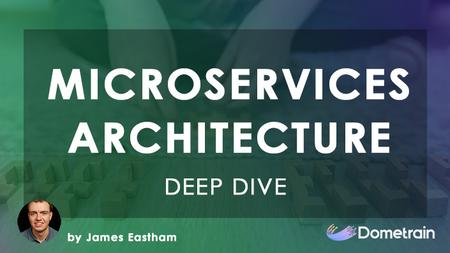English | MP4 | AVC 1920×1080 | AAC 44KHz 2ch | 82 Lessons (4h 18m) | 1.51 GB
Dive deeper into Microservices Architecture with AWS Solution Architect James Eastham
Microservices Architecture is one of the most popular software architectures. It is the de facto choice for any big company, and knowing how to create a system using it is crucial for any software developer who wants to work at a big company. However, it is a very complex topic with many nuances, edge cases, and caveats. In this course, AWS Solution Architect James Eastham will use the knowledge he gained building microservices for Amazon Web Services to teach you how to create an entire microservices architecture system. This course is both theory and code-heavy, with many diagrams and detailed explanations for every decision made. Join James on this journey and master Microservices Architecture today.
Table of Contents
1 Welcome
2 What will you learn in this course
3 Who is the course for and prerequisites
4 Getting the most from this course
5 Introducing the Sample Application
6 How big is a microservice
7 The current code-base
8 Your first microservice
9 Integrating your first microservice
10 Introducing integration tests
11 API First Design
12 Mocking microservice integrations
13 Run your microservices
14 Section Recap
15 Independent Testability
16 Defining the different types of tests
17 Unit testing a microservice
18 Integration testing a microservice
19 Contract testing inter-service communication
20 Break a contact, test the test
21 End to tests, good or bad
22 Performance testing your service
23 Load testing your service
24 Section recap (2)
25 Module Introduction
26 gRPC for inter-service communication
27 Deploying new services
28 Is a microservice a single process
29 Your first gRPC microservice
30 Integration test your new service
31 Implement a gRPC client
32 Mocking gRPC for integration tests
33 End to end tests with gRPC
34 Dealing with failure in gRPC
35 Dealing with failure in REST
36 An Introduction to Service Discovery
37 Service Discovery with Consul
38 The Problem with Synchronous Communication
39 An Introduction to Asynchronous Communication
40 Technology Choices for Async Communication
41 Shared Code for Event Communication
42 Event Schemas and the CloudEvents Specification
43 Defining event subscribers
44 Publishing your first event
45 Consuling your first event
46 Asynchronous communication in action
47 Integration test with events
48 Libraries for message driven systems
49 Fault-tolerance in event driven systems
50 Implementing Idempotency
51 Asynchronous Communication Recap
52 Caching
53 Section Recap (3)
54 The Strangler Fig Pattern for decomposition
55 Configure Nginx as a reverse proxy
56 Nginx in action
57 Breaking out the orders API
58 Breaking out inter-module communication
59 An event-first approach to decomposition
60 Handling events inside your monolith
61 Data Persistence during a migration
62 Monolith to microservices recap
63 Microservices architecture in action
64 Section Recap (4)
65 Introduction to secure microservices
66 User Login for ASP.NET Microservices
67 Generating authentication tokens on user login
68 Users Authentication in Action
69 Using JWT claims inside your application
70 Integration testing secure microservices
71 Methods of Service to service authentication
72 Implementing service to service authentication
73 Section Recap (5)
74 Introduction to scaling microservices
75 Platform engineering for deployment pipelines
76 Standardising deployment pipelines
77 Service blueprints for getting started
78 Discoverability in large-scale microservice architectures
79 Auto-generate documentation for async API’s
80 A Brief word on Backstage.IO
81 Considerations of microservices at scale
82 Course recap
Resolve the captcha to access the links!
